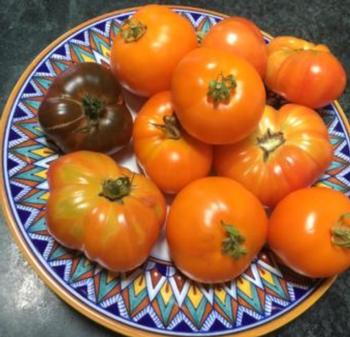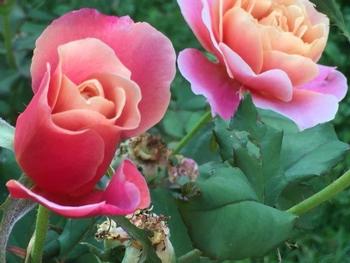Heirlooms versus hybrids - what's the difference
-
Like many of us who search for ancestors through DNA testing for ourselves and our pets, many plants also have a family tree. Each type of plant — open-pollinated, varieties, cultivars, heirlooms and hybrids — have particular advantages. Here’s the terminology that gives us clues about a plant’s ancestry.
An open-pollinated plant simply means that pollination occurred by insect, bird, wind, or other natural mechanism. Seeds from open-pollinated varieties, whether self-pollinated or pollinated by another plant in the same variety, produce plants with roughly the same characteristics as their parents.
 Chef’s Choice Orange tomatoes are popular hybrids. Photo: Marie Narlock
Chef’s Choice Orange tomatoes are popular hybrids. Photo: Marie NarlockA hybrid, by contrast, is a genetic cross between two species typically created through manipulation by human intervention. Man, not nature, twiddled a hybrid’s genes. Hybrids are never heirlooms and therefore they do not “come true” to have the same characteristics as their parents. Hybrids are often bred for specific disease resistance or to have more vigor, predictable uniformity, or the ability to withstand shipping and handling that commercial growers prize.
A variety is a naturally occurring variation of individual plants within a species. Typically, a variety has one or more distinct traits and planting its seeds will usually produce a plant that resembles the parent.
A cultivar means “cultivated variety.” It is a variety propagated for specific desirable traits. If you keep seeds of a cultivar, the sprouts will probably not “come true”—that is, they won’t necessarily be like their parents.Heirlooms are trickier to define. One firm requirement is that an heirloom must have been open-pollinated. Heirlooms have evolved to handle particular microclimates through generations of open pollination. Compared with hybrids, heirlooms maintain genetic diversity within a species. They might have unusual colors and growth characteristics, and vegetables often have flavors commercial hybrids lack. Distant Drum, heirloom rose. Photo: Phoebe Baker
Distant Drum, heirloom rose. Photo: Phoebe Baker
Although all heirlooms are open-pollinated, not all open-pollinated varieties are heirlooms. The difference is age. Many heirlooms are treasures family members loved, saved and handed down through generations. But seed companies have also saved, maintained, and handed down seeds.
Many heirlooms may be traced back many generations. A popular school of thought limits heirloom varieties to those at least 50 years old. Some say 100 years. Others attempt to pin down a time before hybrids became widely used by growers and seed companies.
Before labeling a variety an heirloom, the Seed Savers Exchange verifies and documents the generational history of preserving and passing on the seeds. The Slow Food organization’s International Ark of Taste catalogs specify delicious heirlooms facing extinction. For gardeners, these efforts and others by groups of seed savers and companies have resulted in a wide range of unique, available heirloom seeds, many of which come with fascinating pedigrees and stories.For example, an elderly Ohio gardener gave ‘Brandywine’ tomato seeds to the Seed Savers Exchange in 1882. He had received them from a woman whose family had handed them down for more than 80 years. Several companies offer seeds for storytelling in the USA Art of Taste. Among them, the ‘Hopi Yellow’ and legendary ‘Moon and Stars’ watermelons, and the native American sweet ‘Paw Paw’ fruit. The Cherokee ‘Trail of Tears’ pole bean was first offered though the Seed Savers Exchange in 1977 by Dr. John Wyche, a gardener, seed preservationist, circus owner, and dentist from Hugo, Oklahoma. Wyche said his Cherokee ancestors carried the beans with them during the Trail of Tears in the winter of 1838.
“During the last ten years, we’ve seen more and more heirloom seeds become widely available, some from seed savers and some from big companies,” says Renee Shepherd of Renee’s Garden seed company. “People want heirlooms, so they aren’t as hard to get anymore. It’s become a business. They’re wonderful and old timey. But, they aren’t magic. You should grow the best tasting and most productive vegetables for your climate.”
Original text by Barbara Robertson
Edited for the Leaflet by Jane Scurich


